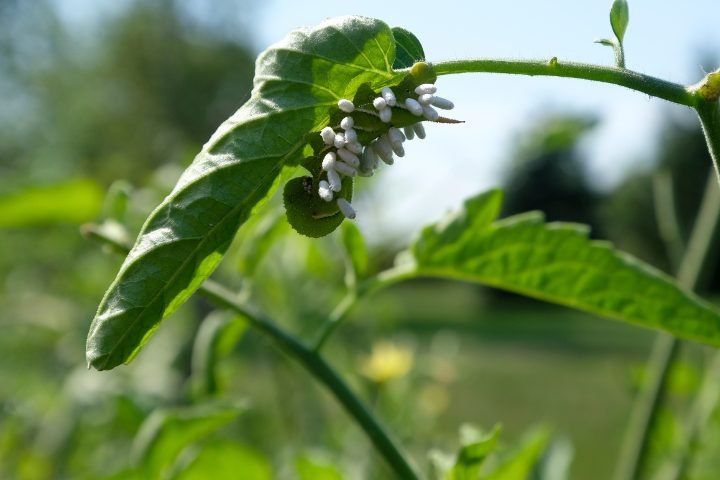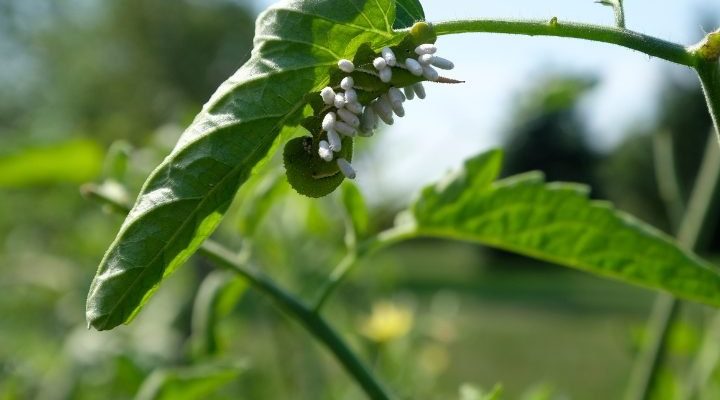
Hornworms, specifically the **tomato hornworm**, can be a bit of a mystery. They have a unique life cycle that plays a big role in whether you’ll see them again. Think of them as the “seasonal visitors” of the insect world. Like a family member that pops in during summer for barbecues, hornworms can show up in your garden under the right conditions. But understanding their habits can help you keep your plants safe and healthy.
What Are Hornworms Anyway?
Let’s start with the basics. Hornworms are the larvae of moths, primarily the **five-spotted hawk moth**. They’re green, can grow up to 4 inches long, and have a horn-like protrusion on their rear—hence the name. They can be easy to spot because they blend in so well with the leaves of plants, making them a sneaky pest.
After hatching from bright green eggs, hornworms start munching on your plants. They’ll primarily feast on **tomatoes**, but they also like **peppers**, **eggplants**, and even **tobacco plants**. This feeding frenzy can lead to significant damage if you don’t catch them early. So, if you’re wondering, “Do hornworms come back year after year?” a bit of background knowledge on their life cycle can help.
The Life Cycle of a Hornworm
To really understand if hornworms come back, we need to look at their life cycle. Here’s a simplified version:
1. **Egg Stage**: Female moths lay tiny, green eggs on the undersides of leaves. These are often hard to spot.
2. **Larva Stage**: After a few days, the eggs hatch, and tiny hornworms emerge. They start feeding and growing fast.
3. **Pupa Stage**: Once they’re full-grown, they’ll drop to the ground and bury themselves, turning into a pupa.
4. **Adult Moth Stage**: After several weeks, a moth will emerge from the pupa, ready to lay more eggs.
So, do they come back? The answer lies in this life cycle. If the conditions are right—like a warm spring and plenty of host plants—you might see hornworms returning each year.
Do Hornworms Survive Winter?
One of the biggest questions is whether hornworms survive through the colder months. Usually, they won’t make it through winter in your garden. Here’s why:
– **Pupa Stage**: If they burrow into the soil and enter the pupal stage, they can survive the winter that way. But they need just the right conditions.
– **Temperature**: Once it gets too cold, hornworms can die off. They’re not equipped to handle freezing temperatures.
However, if the environment is perfect—think moderate temperatures and soil that doesn’t freeze—they can stay dormant and pop back up when the weather warms up.
How to Manage Hornworms in Your Garden
If you want to keep hornworms away or manage their return, there are a few strategies you can use:
– **Regular Inspection**: Check your plants frequently. Look for signs of hornworms, such as chewed leaves or droppings.
– **Natural Predators**: Consider attracting birds or beneficial insects that will eat hornworms. For example, wasps are known to lay their eggs inside the larvae, which can help reduce their populations.
– **Neem Oil**: This natural pesticide can deter hornworms without harming your plants. Spray it on affected plants to keep these pests at bay.
Taking proactive steps can help ensure that even if hornworms do come back year after year, they won’t do much damage.
How Can Weather Affect Hornworm Populations?
Weather plays a critical role in whether or not hornworms will be active in your garden each year. Here’s how:
– **Warm Springs**: If you experience a warm spring, hornworms are likely to hatch early. They thrive in warm weather, so if your area has a mild start to the growing season, you might see them sooner.
– **Wet Conditions**: After a good rainfall, the plants are lush, providing plenty of food for hornworms. This can lead to a rapid increase in their population.
– **Cold Snaps**: On the flip side, a late frost can wipe out hornworms before they have a chance to mature and lay eggs for the next generation.
Understanding these factors can help you predict whether hornworms will become a recurring issue in your garden.
Are Hornworms Harmful to My Plants?
Yes, hornworms can be quite damaging.
– **Leaf Damage**: They can strip entire plants of leaves in just a few days, which weakens the plant and reduces its ability to photosynthesize.
– **Fruit Damage**: While they primarily eat leaves, they can also damage the fruit, creating entry points for disease.
– **Overall Stress**: A plant under stress from pests is more susceptible to other problems, like disease and environmental stressors.
If you let hornworms go unchecked, their impact can be significant. Managing them effectively can lead to a healthier garden overall.
To wrap it up, hornworms can indeed make a comeback if the conditions are right. Their life cycle, which involves a pupa stage that can survive the winter, means they have the potential to return in the growing season. But with a little diligence and good garden management practices, you can minimize their impact.
So, when spring rolls around, keep an eye out for those sneaky hornworms. With the right strategies in place, you’ll be better prepared to protect your beloved plants. Happy gardening!

